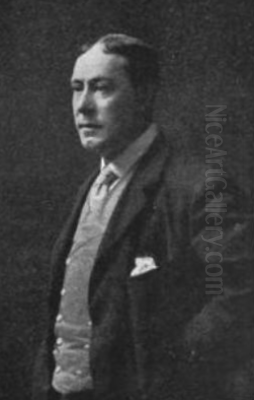
Henry John Yeend King stands as a significant figure in late Victorian and early Edwardian British art. Born in London on August 21, 1855, and passing away on June 10, 1924, King dedicated his career to capturing the idyllic charm and quiet beauty of the English countryside and its inhabitants. He developed a distinctive style that skillfully blended elements of French Realism and Impressionism, adapted to a British sensibility, earning him considerable acclaim during his lifetime and a lasting place in the narrative of British landscape and genre painting. His works remain popular for their gentle nostalgia, technical proficiency, and evocative portrayal of a seemingly timeless rural England.
Early Life and Artistic Beginnings
Henry John Yeend King's journey into the world of art began in the bustling metropolis of London. His parents were William John King and Mary Jane King. His early education took place at Berner's School. Showing an early inclination towards the visual arts, he did not immediately pursue easel painting. Instead, his initial professional training was in the craft of glass painting, a field demanding precision and an understanding of light and colour.
He apprenticed first at the O'Connor glass painting studio in London. Following this, he spent three years honing his skills in glass painting at the studios of Messrs. W. H. Owen. This foundational experience likely instilled in him a strong sense of draughtsmanship and composition. Around 1873, seeking broader artistic instruction, he began studying under William Bromley, a respected Victorian artist known for his genre scenes. This marked a transition towards the more conventional path of painting.
Parisian Training and Continental Influences
Like many ambitious British artists of his generation, Yeend King recognized the importance of experiencing the vibrant art scene of Paris, then the undisputed centre of the Western art world. Around 1874, he travelled to France to further his studies. This period proved crucial in shaping his artistic direction. He enrolled in the ateliers of two prominent French academic painters who also embraced modern trends: Léon Joseph Florentin Bonnat and Fernand Cormon.
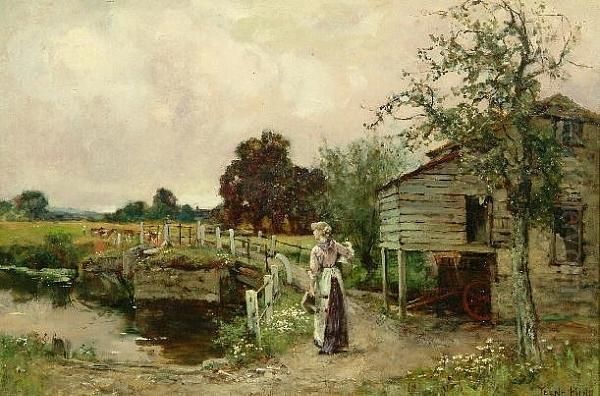
Bonnat was renowned for his portraiture and historical paintings, emphasizing strong draughtsmanship and realism. Cormon, famous for his dramatic historical and prehistoric scenes, also ran a liberal studio that attracted many international students, including figures like Henri de Toulouse-Lautrec and Vincent van Gogh (though likely at different times than King). Studying under these masters exposed King directly to contemporary French techniques and artistic debates.
Crucially, his time in Paris coincided with the height of Impressionism and the enduring influence of French Realism. King absorbed the Impressionists' fascination with capturing fleeting effects of light and atmosphere, their brighter palette, and their practice of painting en plein air (outdoors). Artists like Claude Monet, Camille Pissarro, and Alfred Sisley were revolutionizing landscape painting. Simultaneously, the legacy of Realists such as Jean-François Millet and Jules Bastien-Lepage, who depicted rural life with dignity and truthfulness, resonated deeply with King's own inclinations.
Forging a Distinctive Style
Upon returning to England, Yeend King did not simply replicate the styles he had encountered in France. Instead, he synthesized these continental influences with a distinctly British sensibility. While clearly impacted by Impressionism, particularly in his handling of light and often broken brushwork, his approach remained more restrained and detailed than that of his French counterparts. He shied away from the complete dissolution of form sometimes seen in Monet's work, retaining a strong commitment to realistic representation.
His style is often characterized as a blend of Realism and a tempered Impressionism. He excelled at rendering textures – the rough fabric of a peasant's dress, the sun-dappled foliage of trees, the reflective surface of water. His compositions are carefully constructed, often featuring figures integrated harmoniously within the landscape. Unlike some French Impressionists such as Edgar Degas, who frequently depicted modern urban life, King consistently turned his gaze towards the countryside, finding his subjects in the fields, farms, and villages of rural England.
He became particularly adept at plein air painting, capturing the authentic light and colours of the English landscape directly from nature. This practice, learned and refined during his time in France, lent his work a freshness and immediacy. However, his paintings often possess an idyllic, sometimes sentimental quality, presenting a peaceful and harmonious vision of rural existence that appealed greatly to Victorian audiences seeking an escape from the rapid industrialization and urbanization of the era.
Themes of Rural England

The dominant theme throughout Henry John Yeend King's oeuvre is the English countryside and the lives of its inhabitants. He possessed a genuine affection for rural life, even though he resided primarily in London for much of his career. His paintings celebrate the rhythms of agricultural work, the simplicity of village life, and the beauty of the natural landscape.
His canvases are populated with figures, often young women and girls, engaged in everyday tasks: tending gardens, minding livestock, resting by streams, or simply pausing in quiet contemplation amidst nature. These figures are typically depicted with a gentle grace and are seamlessly integrated into their surroundings, emphasizing a harmonious relationship between humanity and the natural world. Cottages nestled amongst trees, tranquil rivers winding through meadows, blossoming orchards, and sunlit farmyards are recurring motifs.
King travelled extensively throughout England, particularly favouring regions like Surrey, Sussex, and notably Dorset, seeking picturesque locations and authentic scenes. His work often evokes a sense of nostalgia for a pre-industrial, pastoral England, presenting an idealized vision that resonated with contemporary viewers. His focus on specific locations, such as Cerne Abbas in Dorset, demonstrates his commitment to capturing the unique character of the English landscape. His approach can be seen in relation to other British artists depicting rural life, such as Helen Allingham with her charming cottage scenes, or George Clausen who, influenced by French Naturalism, often portrayed agricultural labour with a greater degree of social realism.
Notable Artworks
Yeend King's prolific output includes many works that exemplify his characteristic style and subject matter. Among his representative paintings are:
Loiterers: Exhibited early in his career (at the RBA in 1883 and possibly a different version or another work of the same name at the RA later), this title suggests a typical genre scene of figures pausing in a rural setting, allowing King to explore character and atmosphere. Critical reception for a work of this title exhibited later was positive, praising its handling of light.
The Girl by the Factory Lake: This title is somewhat unusual given his typical focus, but it likely showcases the plein air techniques honed in France, perhaps depicting a figure in a landscape near, but distinct from, an industrial element, or simply using "Factory Lake" as a place name.
Still Waters: Evokes the tranquility King often sought, likely depicting a calm river or pond, focusing on reflections and the peaceful atmosphere of the countryside.
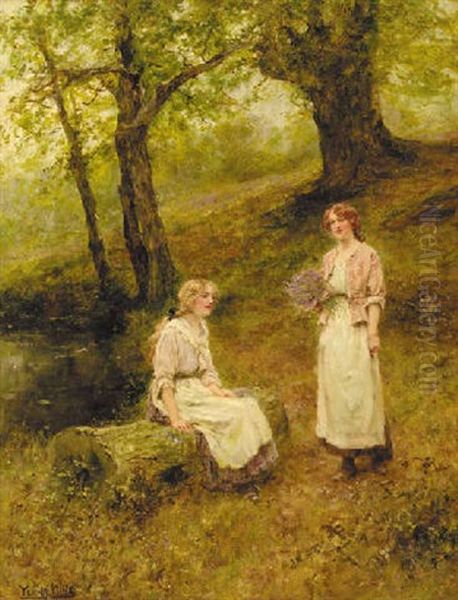
A Woman with a Dog in the Evening Light: A characteristic genre scene, combining a sympathetic portrayal of a rural figure with the challenge of capturing the specific, warm light of dusk.
Milking Time (1898): A classic pastoral subject, depicting a common agricultural task. A version of this work is held by the Tate collection, indicating its significance.
In a Dorset Lane Moving the Flock: Painted during the 1890s, this work clearly reflects his time spent in Dorset, capturing a specific moment of rural activity within a defined landscape.
The Mill Stream, In a Dorset Village, and Cerne Abbas, Dorset: These three works were exhibited together in 1895, showcasing his focus on the Dorset region and its picturesque qualities.
Three Score Years and Ten and Christmas Morning: Titles suggesting narrative genre scenes, likely depicting moments of family life or community tradition within a rural setting.
River Banks and Blossoming Cherry Trees: A celebration of spring in the countryside, allowing King to explore vibrant colour and the ephemeral beauty of blossoms.
A Rest in the Woods, Conversation in the Garden, In the Garden, Picnic on the River, and Landscape with Figures: These titles further illustrate his recurring themes of leisure, social interaction, and figures harmoniously situated within natural or cultivated landscapes.
These works, among many others, demonstrate King's consistent dedication to his chosen themes, his technical skill in rendering light and detail, and his ability to create evocative and appealing images of English rural life.
Professional Recognition and Exhibitions
Henry John Yeend King achieved considerable success and recognition within the established art institutions of his time. His talent was acknowledged early in his career when, in 1879, he was elected a member of the Royal Society of British Artists (RBA), a prestigious exhibiting society based in Suffolk Street, London. He regularly exhibited works there, including Loiterers in 1883.
His skill, particularly in watercolour, led to his election as a member of the Royal Institute of Painters in Watercolour (RI) in 1886. He became deeply involved with this institution, later serving as its Vice-President, a testament to the high regard in which he was held by his peers. He was also a frequent exhibitor at the Royal Academy of Arts (RA), the most important venue for contemporary artists in Britain. Between 1876 and 1924, he exhibited numerous works at the RA's annual summer exhibitions.
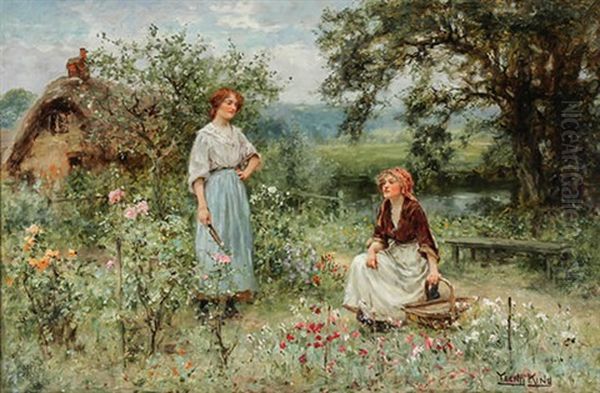
Beyond these major London societies, King also exhibited his work elsewhere in the UK, including occasionally at the Belfast Art Association. His reputation extended internationally; he exhibited his paintings in Europe and the United States, winning awards in major cities such as Paris, Berlin, and Chicago. A notable event was the 1895 summer exhibition themed "Wessex" at Dickinson & Foster's gallery on New Bond Street, London. King contributed three Dorset-themed paintings, and the exhibition attracted royal attention, being visited by the Prince of Wales (the future King Edward VII).
His works were acquired by public collections during his lifetime and after, solidifying his status. Today, his paintings can be found in institutions such as the Tate Britain (London), the Walker Art Gallery (Liverpool), Reading Museum, Manchester Art Gallery, Leicester Museum & Art Gallery, and the Brampton Museum in Newcastle-under-Lyme, among others.
Context within Victorian Art
Henry John Yeend King worked during a period of great diversity in British art. The dominant force of Academic painting, represented by figures like Lord Leighton and Sir Lawrence Alma-Tadema, coexisted with the lingering influence of the Pre-Raphaelite Brotherhood (with artists like John Everett Millais moving towards broader styles in later life) and the rise of new movements.
King's work aligns with a significant trend in late Victorian art: the depiction of rural life and landscape, often tinged with nostalgia or social commentary. He can be situated alongside artists of the Newlyn School in Cornwall, such as Stanhope Forbes and Walter Langley, who also embraced plein air painting and focused on realistic depictions of working communities, though often with a grittier, less idealized tone than King. His gentle, picturesque style also finds parallels in the work of watercolourists like Myles Birket Foster, who specialized in charming, detailed views of the English countryside.
While influenced by French Impressionism, King and many of his British contemporaries adapted its techniques to suit national tastes, which often favoured more narrative content and detailed finish than was typical of Monet or Pissarro. King's particular blend of realism, atmospheric light effects, and appealing subject matter proved highly successful, making him one of the most popular and respected painters of rustic genre in his day. He represented a comforting vision of England's heritage amidst rapid social and industrial change.
Critical Reception and Legacy

During his lifetime, Henry John Yeend King enjoyed a favourable critical reception. His works were regularly reviewed in the art press, often praised for their technical accomplishment, truthful observation of nature, and charming subject matter. Critics noted his skill in capturing the effects of English light and weather, his careful draughtsmanship, and the pleasant, poetic atmosphere of his paintings. His ability to combine figurative painting with landscape was frequently commended.
While acknowledged as being influenced by French painting, his work was seen as distinctly English in its sentiment and focus. The idyllic and often sentimental nature of his scenes resonated strongly with the public, ensuring the popularity of his work at exhibitions and healthy sales. His election to prominent art societies like the RBA and RI, and his role as Vice-President of the latter, further attest to his professional standing.
His legacy lies in his contribution to the tradition of British landscape and genre painting. He created a significant body of work that documents, albeit through an idealized lens, the appearance and activities of rural England in the late 19th and early 20th centuries. His paintings offer a valuable visual record of pastoral life before the profound changes brought about by mechanization and war. Today, his works continue to be admired for their technical quality, evocative charm, and nostalgic appeal, representing a specific and much-loved vision of the English countryside.
Personal Glimpses and Anecdotes
Beyond his artistic output, glimpses of Henry John Yeend King's personality suggest an engaging individual. An anecdote from his childhood involves his time as a choirboy, where he was reportedly punished for forgetting to contribute his five pence towards a stained-glass window fund – perhaps an early, albeit indirect, connection to the world of art and glass.
Despite his focus on rustic subjects, King was described as looking less like the stereotypical long-haired, unconventionally dressed artist and more like a professional man, with neatly trimmed hair and tidy attire. However, he was also considered a "true Bohemian" at heart, known for his humour, engaging conversation, and repertoire of stories. This suggests a personality that combined professional discipline with a free-spirited outlook.
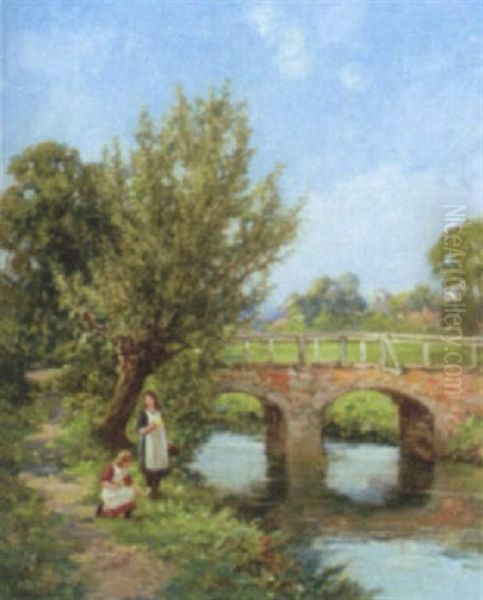
His dedication to his subject matter was profound. Although primarily based in London, his frequent travels throughout England and France in search of inspiration underscore his commitment to firsthand observation. His repeated visits to specific locations like Cerne Abbas in Dorset highlight his deep connection to the landscapes he painted. This blend of professionalism, personal charm, and dedication to his craft contributed to his success and the enduring appeal of his work.
Conclusion
Henry John Yeend King carved a distinct and respected niche for himself within the British art world of the late Victorian and Edwardian eras. Through dedicated study, keen observation, and a genuine affection for his subject matter, he developed a highly appealing style that captured the essence of English rural life. By skillfully blending the techniques of French Realism and Impressionism with a native sensibility, he created works that were both technically proficient and emotionally resonant. His paintings, filled with gentle light, picturesque scenery, and sympathetically rendered figures, continue to evoke a powerful sense of place and a nostalgic longing for a simpler, pastoral past. As a chronicler of the English countryside, his contribution remains significant and his works continue to be cherished.